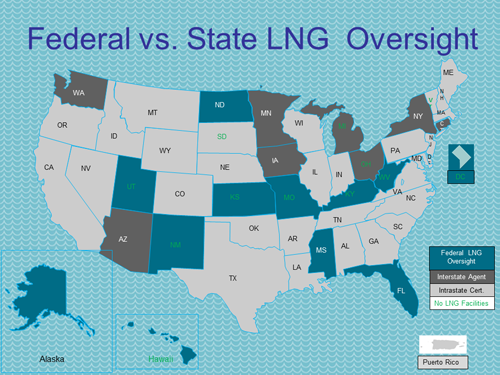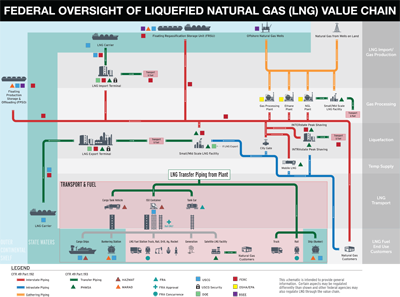Jurisdiction of LNG Plants
Federal Oversight of LNG Value Chain
Several federal agencies play a role in the oversight of LNG facilities. The schematic below provides a high level view of the federal oversight of the LNG value chain.
US DOT PHMSA
The Natural Gas Pipeline Safety Act of 1968, as amended, (NGPSA) authorizes the U.S. Department of Transportation to regulate pipeline transportation of natural (flammable, toxic, or corrosive) gas and other gases, as well as the transportation and storage of LNG. The Pipeline Safety Statute codified in 49 U.S. Code § 60101, et seq, directs US DOT to establish and enforce standards for liquefied natural gas pipeline facilities. PHMSA's regulations are found in Title 49 Code of Federal Regulations Part 193 Liquefied Natural Gas Facilities.
An LNG facility is a gas pipeline facility used for converting, transporting or storing liquefied natural gas. Many LNG facilities are subject to the regulatory and enforcement authority of the Department of Transportation through PHMSA. A simple but not complete test to determine if an LNG facility is regulated under 49 CFR Part 193 is to identify both the source and the consumer of the LNG. The facility is regulated under 49 CFR Part 193 if the LNG facility either receives from or delivers to a 49 CFR Part 192 pipeline.
49 CFR Part 193 does not apply to:
(1) LNG facilities used by ultimate consumers of LNG or natural gas.
(2) LNG facilities used in the course of natural gas treatment or hydrocarbon extraction that do not store LNG.
(3) In marine cargo transfer systems and associated facilities, any matter other than siting pertaining to the system or facilities between the marine vessel and the last manifold (or, in the absence of a manifold, the last valve) located immediately before a storage tank.
(4) Any LNG facility located in navigable waters (as defined in Section 3(8) of the Federal Power Act (16 U.S.C. 796(8)).
Operators should assume an LNG facility used in the transportation of gas by a 49 CFR Part 192 pipeline is regulated under 49 CFR Part 193 unless specifically exempted in Section 193.2001(b). LNG facilities may be regulated by PHMSA even though they are not regulated by the FERC.
The 'ultimate consumer' provision provides a very limited exemption from 49 CFR Part 193. PHMSA interpretation # PI-10-0025 provides guidance. Here is an excerpt:
During the rulemaking that led to the adoption of § 193.2001(b)(1), OPS explained that the intent of that provision was to create an exception for "an LNG facility used by the ultimate consumer of the product". Likewise, in responding to a series of questions from a congressional committee, OPS stated that the exception in § 193.2001(b)(1), was designed for "small" facilities which are "generally located in industrial plants ... [to] serve as a supply of energy or feedstock for the plant." Unlike these examples, the Maine LMF facilities would be used to produce LNG for sale and distribution by truck, not solely for onsite consumption. Therefore, OPS concludes that your client's facilities would not qualify for the end-user exception in § 193.2001(b)(1).
Operator compliance with federal and state LNG safety regulations is monitored through a comprehensive inspection and enforcement program and through direct dialogue with operator management. State agencies work in partnership with PHMSA to assure jurisdictional operators are meeting requirements for safe, reliable, and environmentally sound operation of their facilities. Below is a map that shows the regulatory authority over intrastate and interstate LNG facilities.
Blue – US DOT PHMSA oversight for all LNG facilities
Black – State oversight for all LNG facilities
Gray – State oversight for all intrastate LNG facilities
Green – No LNG facilities in the state

More information is available regarding federal/state partnerships.
FERC
FERC is responsible for authorizing the siting and construction of onshore and near-shore LNG import or export facilities under Section 3 of the Natural Gas Act. Additionally, FERC inspects peak-shaving, LNG satellite, and vehicular fuel LNG plants connected to the interstate gas transmission system. The Commission, under Section 7 of the Natural Gas Act, also issues certificates of public convenience and necessity for LNG facilities engaged in interstate natural gas transportation by pipeline. As required by the National Environmental Policy Act (NEPA), FERC prepares environmental assessments or impact statements for proposed LNG facilities under its jurisdiction. FERC is the lead federal agency under NEPA to analyze the environmental, safety, security, and cryogenic design of proposed LNG facilities.
FERC regulations are found in Title 18 Code of Federal Regulations (18 CFR) Chapter 1, Subchapter E. LNG projects which are approved and built are subject to FERC oversight for as long as the facility is in operation. As of 2016, FERC listed 24 operational LNG facilities under its regulatory jurisdiction. Follow this link for additional details on FERC's responsibilities in regulating LNG facilities and maps showing existing, approved, and proposed North American LNG projects, as well as FERC jurisdictional LNG peak-shaving plants.
For additional details on FERC's LNG siting process, visit http://www.ferc.gov/industries/gas/indus-act/lng.asp.
U.S. Coast Guard
The USCG has authority and regulates the marine transfer areas for each new waterfront facility handling LNG. USCG also regulates new construction in the marine transfer area for each existing waterfront facility handling LNG. The USCG conducts waterway suitability assessments to address navigation safety and port security issues associated with LNG ship traffic. USCG regulations pertaining to waterfront facilities handling LNG are identified in 33 CFR Part 127. For additional details, see the USCG Navigation And Vessel Inspection Circular (NVIC) No. 01-2011.
The USCG is responsible to develop and maintain regulations and standards for deepwater ports and for processing deepwater port license applications. The Maritime Transportation Security Act of 2002 (MTSA) amended the Deepwater Port Act (DWPA) of 1974, 33 United States Code 1501, et seq., to include natural gas. This allowed for the construction and operation of offshore facilities to import and process natural gas for distribution through the country's pipeline infrastructure. The USCG coordinates agency and public reviews and participation in the deepwater port licensing process. The USCG manages the development of a single environmental impact statement (EIS) for compliance with the National Environmental Policy Act of 1969 (NEPA) for deepwater port license applications and associated federal permits. The USCG develops guidance for oversight of post-licensing activities associated with the development of deepwater ports including the design, construction, and activation phases, environmental monitoring programs, operational procedures, risk assessments, security plans, safety and inspections. The USCG also maintains and updates the regulations for deepwater ports, found in 33 Code of Federal Regulations (CFR) Subchapter NN. Follow this link for additional details on the U.S. Coast Guard role in deepwater port siting.
The USCG and the U.S. Department of Transportation's (DOT) Maritime Administration (MARAD) share responsibility for the safety, security, and environmental review of deepwater port terminals.
Maritime Administration
The DWPA, as amended, establishes a licensing system for ownership, construction, operation and decommissioning of deepwater ports located offshore beyond State waters for the import and export of oil and natural gas. The DWPA sets out conditions and procedures for the issuance of deepwater port licenses by the Secretary of Transportation (Secretary). The Secretary has delegated the authority to "carry out the following powers and duties and exercise the authorities vested in the Secretary by the Deepwater Port Act of 1974" to the Maritime Administrator.
The Maritime Administrator is responsible for determining the financial capability of potential licensees, the citizenship of the applicant, and is responsible for preparing the project Record of Decision (which includes the decommissioning analysis) and finally, for issuing or denying the deepwater port license. Several duties under the DWPA, including consultation, are shared with the U.S. Coast Guard. For example, the Maritime Administration and the U.S. Coast Guard, in cooperation with other Federal agencies, must ensure compliance with the requirements of the National Environmental Policy Act.
The Maritime Administrator will render a final decision licensing decision based on the applicant's ability to meet and comply with the following nine criteria as set forth in the Deepwater Port Act of 1974:
- Demonstrate Financial Responsibility
- Demonstrate Compliance with Relevant Laws, Regulations, and License Conditions
- Determination of National Interest
- Non Interference with International Navigation
- Minimal Impact on the Marine Environment
- Compliance with National Environmental Laws
- Consultation with the Secretaries of the Army, State and Defense
- Approval of the Governor of the Adjacent Coastal State
- Consistency with Coastal Zone Management Program(s)
The Maritime Administration's decision to approve, approve with conditions or deny the application is documented in a Record of Decision that includes a summary of the nine criteria outlined above as well as a summary of the environmental conditions derived from the EIS process. Subsequently, upon further demonstration of financial capability to construct, operate and decommission the deepwater port, the Maritime Administrator may issue a license for the deepwater port.
Visit the MARAD website for additional details on the MARAD deepwater port licensing program.

